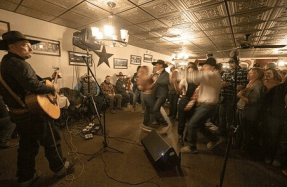SECOND CITIZENS


APRIL 2020, AND THE NOVEL CORONAVIRUS was spreading through the United States. As businesses closed and hospitals filled, Jim Moran found himself sheltering in place in Colorado, at his second home. His mansion has dark wood siding and a jutting patio, and it perches on a bluff above Crested Butte, a small snow globe of a town whose brightly painted cottages huddle at the base of mountains at the north end of the Gunnison Valley, a long thin basin high in the Rockies. Moran is from Dallas, Texas, where he managed private equity firms. From his back door, he can ski directly onto Mount Crested Butte, one of Colorado’s iconic ski resorts. Moran speaks quickly and passionately and has swept-back silver hair. Housing prices in rural towns have surged since the pandemic as well-to-do people flee cities. Moran’s property, which he bought in 2013, has appreciated: Were he to list his house today, Zillow estimates the value at $4.3 million.
When COVID-19 came to the valley, the outbreak was so severe that the 17,400 residents of Gunnison County — which includes Crested Butte, the valley and a few outlying towns — faced one of the highest rates of cases per capita in the entire country. The county’s response was drastic: On April 3, it directed all visitors, tourists and part-time residents to leave, explicitly banning non-resident property owners, of which there are more than 4,000. The order, signed by the county’s public health director, cited the strain on local services: “Non-residents, regardless of whether they own a residence in Gunnison County, are imposing unnecessary burdens on health care, public services, first responders, food supplies and other essential services.” Violators could be fined up to $5,000 or jailed for up to 18 months.
Moran decided to stay put. He was upset, and he was far from alone. The next day, another Dallas resident with a home in the valley created a private Facebook group, eventually called GV2H & Friends Forum, for Gunnison Valley second-home owners in the area to gather and commiserate. The group swelled quickly to several hundred members. The order was divisive, one person wrote in a comment; it made non-residents feel like “outcasts,” wrote another. Many questioned the county’s wisdom in forcing them to travel during the pandemic. Then there were the legal issues. Moran told me that a key question was: “Can they just tell me I can’t use my property?”
Some Texans in the group — and there are many; the Gunnison Valley has been a popular vacation spot for oil-rich Texans since the early 1900s — turned to the office of Texas Attorney General Ken Paxton for help. On April 9, Paxton asked Gunnison County to reconsider, arguing that the Texans’ property rights were being violated. (Soon after, the Associated Press revealed that several of Paxton’s associates, including a college friend and high-dollar campaign donors, own houses in Crested Butte. This fall, seven of his senior staff accused him of taking bribes and using his office to favor political donors; the FBI is now investigating.)
About a week after the order, nonresident homeowners received cards in the mail from the county. “While full-time residents of Gunnison County work to weather the coronavirus health crisis, non-resident homeowners are ordered to leave Gunnison County and not return until further notice,” the card said. Days later, the county backtracked a bit, saying that nonresident homeowners who had already quarantined in Gunnison could remain. Even so, many felt the county had gone too far. Something needed to be done
Jim Moran had an idea. Two of the three seats on the board of county commissioners, the most powerful local governmental body, were up for re-election in November. That included Commissioner Jonathan Houck, who had endorsed the ban. Moran polled the GV2H & Friends Forum about creating a super PAC — an independent political spending organization that can receive unlimited donations but cannot donate directly to campaigns — to influence the county races. The response was enthusiastic. Moran and other second-home owners set out to find and support candidates more aligned with their interests, people who, if elected, would not ban them from their property. They thought they might win a majority on the commission. “There has never been a better opportunity for change,” Moran wrote on April 29, “and we intend to exploit that to the fullest extent possible.”
THE HILLS ABOVE CRESTED BUTTE, which are layered with gold, silver and other minerals, attracted prospectors in waves in the 1870s. Ranchers and homesteaders followed, motivating the forced removal of Ute tribal bands from land that they had called home for centuries. A coal mine opened in 1894 and sustained many livelihoods for the first half of the 20th century.

In the valley
You’re reading a preview, subscribe to read more.
Start your free 30 days





